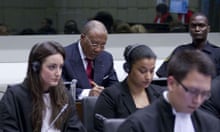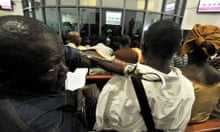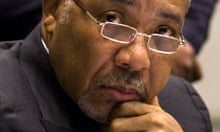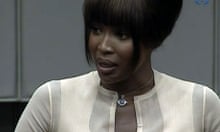Student activist, accountant, fugitive from US justice, Libyan-trained guerrilla, warlord, president, cannibal, dealer in blood diamonds, war crimes scapegoat – the multiple masks worn by, or imposed on, Charles Taylor would tax any actor portraying the dapper Liberian showman.
As a child, he helped his father cut sugar cane on their farm in rural Liberia, 30 miles north of the capital, Monrovia. He later recalled walking to school shoeless – but Taylor was not from a deprived background.
His father was one of the relatively privileged Americo-Liberian elite that had run the west African state since its foundation in 1847 as an independent republic for freed US slaves.
His mother was an indigenous Liberian from the Gola tribe. That dual inheritance in a divided country enabled him to reach out to followers across both Africa and the United States. Born with the middle name McArthur, he later changed it to Ghankay, meaning "strong one" in the Gola language.
After leaving school, Taylor became a teacher and fathered a child at 20. He moved to Monrovia, became an accountant in the ministry of finance then decided a US college education would help him to move up in the world.
At Bentley College, Massachusetts, Taylor acquired a Chevrolet Cougar sports car, a Trinidadian girlfriend and a second child, Chucky. He switched to economics and forged links with the expatriate Liberian community.
His political ambitions flourished, as he addressed rallies demanding democracy and development in his homeland. One protest outside the White House involved the carrying of a mock coffin of the Liberian president, William Tolbert.
An increasingly prominent critic of the regime, Taylor was invited back to Monrovia in 1980 to advise on modernising the country. Two months later, a military coup removed Tolbert and the Americo-Liberian ascendancy, initiating decades of bloodletting and civil war.
The junta leader Samuel Doe, a former army sergeant, made Taylor head of the country's procurement unit and gave him a cabinet post. In 1983, Taylor fell out with Doe over allegations of overpayments by his agency to a New Jersey manufacturer. Discredited, he fled the country.
The following year, he was arrested by the FBI in Boston after Doe issued an international arrest warrant. Taylor denied he had taken the missing cash and implied corruption lay elsewhere in the junta. He was detained in a Massachusetts house of correction for more than a year.
In 1985, he escaped, triggering rumours of US government complicity. (In evidence to the court in The Haque, Taylor claimed he had simply been released.) Soon over the border into Mexico, he returned to west Africa.
There he established a movement to overthrow the increasingly tyrannical president, Doe. Taylor also charmed his way into a desert training camp for revolutionaries run by Colonel Muammar Gaddafi of Libya; another guest was Fodoy Sankoh, leader of a rebel group in Sierra Leone – Liberia's western neighbour – who would soon become a close ally.
The National Patriotic Front for Liberia (NPFL) launched its military invasion in 1989, a conflict characterised by recruitment of child soldiers, massacres, looting and rapes. Doe was eventually captured and tortured to death by a rival faction. African peacekeepers intervened to protect the civilian population. Amid the chaos, Sankoh's Revolutionary United Front (RUF), backed by Taylor's NPFL, crossed into Sierra Leone, and began a campaign of violence and intimidation.
Within a few years, the RUF had seized the country's gold and diamond fields. Precious stones began flowing out through Liberia. Battle lines surged back and forth. Elections were called in 1996. Defeated in the first round of the polls, Sankoh targeted civilians. His soldiers mutilated villagers, amputating their arms with machetes. The slogan "No arms, no elections" was intended to spread terror and panic.
It is Taylor's contested role during the period between 1996 and early 2002 – when the civil war in Sierra Leone ended – for which he has been on trial at the special court for Sierra Leone in The Hague. Taylor has admitted giving "small amounts of arms and ammunition" to help the RUF during the very early 1990s but denied giving assistance during the later period.
He argued in court that he used his influence to end the war in the neighbouring west African state and eventually sealed the border, formally withdrawing his support for the rebels.
In response to prosecution allegations that he traded arms for Sierra Leonean blood (or conflict) diamonds, Taylor testified that it would not have been possible because neither of the two roads that led to the Sierra Leone border could support vehicles laden with weapons.
Having fought his way to military dominance in Liberia, the flamboyant rebel leader was finally elected president in 1997 with more than 75% of votes in an election that most poll monitors deemed to be largely a fair contest. His nearest rival, Ellen Johnson Sirleaf, who is now president, took only 10% of the votes.
Why a man commonly derided as a brutal warlord should win so clearly puzzled many foreign journalists. But Taylor, nicknamed "Papay", had gained a reputation as a family man. As head of the strongest military faction, it was also reasoned by Liberians that he could bring stability to a wartorn country.
A series of murders and disappearances attributed to his personal security forces early in his presidential term rapidly disillusioned supporters in Monrovia and abroad. One militia, the Anti-Terrrorist Unit, was controlled by his son Chucky, who had moved from the US to join him. (In 2009, Chucky Taylor was convicted by a Florida court under a law that allows US citizens to be tried for acts of torture committed overseas. He is serving a 97-year sentence.)
The president's reputation abroad suffered. A further surge in violence in Sierra Leone in 1999 led the Clinton administration to impose a travel ban on Taylor and his family to put pressure on him to end support for the RUF.
Sierra Leone accused its neighbour of shipping to Antwerp 40 times the quantity of diamonds that Liberia was capable of producing from its own mines.
Allegations that Taylor had participated in ritualistic cannibalism surfaced in this period. He sued the Times for libel but the case never came to trial. In The Hague courtroom, a prosecution witness, Joseph "Zigzag" Marzah, maintained that he and Taylor had eaten human hearts together. The juju practice is supposed to enable the victor to absorb his victim's powers. The former president's lawyers dismissed the claims as untrue and denied that Marzah had ever been close to Taylor. "I felt like throwing up when I heard that nonsense," Taylor told the court, "and I think even the prosecution were shocked at listening to that foolishness."
A showman by nature, Taylor often appeared dressed head to toe in white robes to proclaim his innocence and stress his supernatural or pseudo-angelic status. An eager adapter of religious symbols, he even announced once that he had converted to Judaism.
The formation in 1999 of Liberians United for Reconciliation and Democracy (LURD) marked the beginning of the end. There were UN security council resolutions condemning his regime for arms sales and in 2002 the UN-sponsored special court for Sierra Leone was established.
The next year, Taylor was indicted for war crimes, LURD forces stormed into Monrovia and the president boarded a plane bound for exile in Nigeria. It took several more years to manoeuvre him into the hands of the court.
As his arrest neared, he fled his villa and was eventually captured at 5am in a car heading for the border with Chad. He was carrying $50,000 in cash.
Sent to Freetown, the capital of Sierra Leone, he was transferred in June 2006 to the Netherlands to face the protracted process of international justice. The death of Sankoh, from a stroke while in detention, left Taylor in the international limelight.
Opening his defence before the war crimes court, his lawyer, Courtenay Griffiths QC, presented Taylor as a victim of western powers who wanted regime change in Liberia, a peacemaker in regional conflict who had become a scapegoat of the international community.







